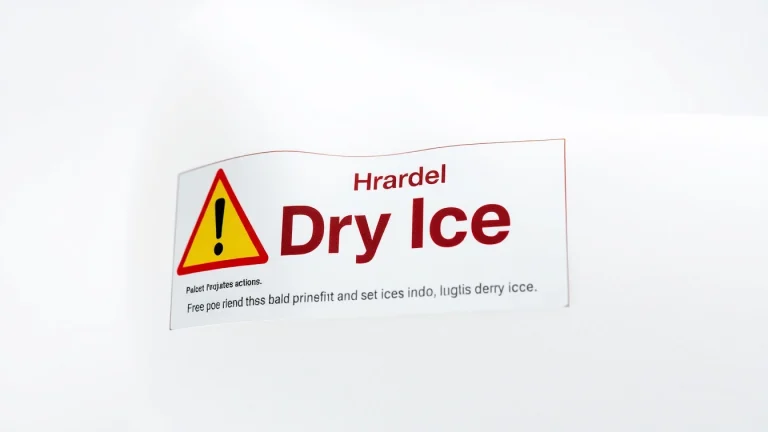
Essential Dry Ice Labeling Guidelines for Safe and Compliant Shipping
Understanding Dry Ice Labels and Their Importance
Dry ice, which is solid carbon dioxide, is widely used in shipping, especially for items that require refrigeration or preservation. To ensure the safe transport of dry ice, proper labeling is essential. A dry ice label serves not only as a means of identification but also communicates crucial safety information to handlers and recipients alike.
What is a Dry Ice Label?
A dry ice label is specifically designed to indicate that a package contains dry ice and complies with the United Nations (UN) regulations for hazardous materials. The label prominently features the UN number “UN1845,” which is the identifier for dry ice, and is typically outlined in a diamond shape. It includes specific instructions and warnings, helping to mitigate the hazards associated with the material.
Regulatory Requirements for Dry Ice Labeling
In the United States, dry ice is classified as a Class 9 miscellaneous hazardous material under Department of Transportation (DOT) regulations. When shipping dry ice, it is mandatory to adhere to specific labeling guidelines. According to the DOT and the Hazardous Materials Regulations (HMR), some essential requirements include:
- Using the correct UN number (UN1845) prominently on the label.
- Providing the net weight of the dry ice, expressed in kilograms.
- Including the name and address of both the shipper and consignee.
- Following all relevant regulations regarding dimensions and display of hazardous materials labels.
Common Uses of Dry Ice Labels
Dry ice is often used in various industries, including:
- Pharmaceuticals: Preserving medications and biological samples during transport.
- Food Industry: Keeping perishable goods cold while in transit.
- Research and Development: Shipping samples or experimental materials that require a specific temperature range.
- Special Events: Creating visual effects (like fog) where dry ice is used for entertainment purposes.
Key Elements of a Dry Ice Label
Required Information on a Dry Ice Label
To ensure compliance and safety, a dry ice label must clearly display several key elements:
- UN Number: “UN1845” must be visible.
- Proper Shipping Name: Either “Dry Ice” or “Carbon Dioxide, Solid” should be included.
- Net Weight: Indicate the weight of the dry ice in kilograms.
- Shipper and Consignee Information: Names and addresses must be included either on the label or on adjacent packaging.
Label Dimensions and Specifications
According to the DOT requirements, dry ice labels need to adhere to specific size standards for clarity and visibility:
- The minimum size for the Class 9 label is generally 100mm on a side, ensuring it remains legible.
- Labels must be durable and capable of withstanding various environmental factors to ensure visibility throughout transport.
Color Coding and Symbol Usage
Dry ice labels typically feature a black and white design with a diamond shape to catch the eye. The Class 9 label is adorned with a ‘Miscellaneous Dangerous Goods’ symbol, which serves as an additional warning. Color coding helps handlers quickly identify potential hazards and ensures proper handling procedures are followed.
Printable Dry Ice Labels: A Step-by-Step Guide
Where to Find Printable Dry Ice Label Templates
Finding and printing compliant dry ice label templates is essential for businesses involved in shipping. Here are several resources:
- Regulatory websites often provide free downloadable templates for dry ice labels.
- Supply chain management companies and distributors like ShipMercury offer templates that meet DOT guidelines.
How to Properly Fill Out the Dry Ice Label
When filling out a dry ice label, accuracy is paramount. Ensure that you:
- Clearly print the UN number, shipper and consignee information, and net weight.
- Use a permanent marker or printed labels to prevent fading.
Essential Printing Tips for Clarity and Compliance
For effective visibility and compliance, consider these printing tips:
- Use industrial-quality printers to ensure ink quality and durability.
- Opt for weather-resistant label materials that comply with DOT standards.
- Monitor printer settings to ensure the proper dimensions are maintained.
Where to Place Your Dry Ice Label on Packages
Correct Placement for Visibility
To maximize safety, proper placement of the dry ice label is crucial. It must be affixed to:
- The main vertical surface of the package for clear visibility.
- All external sides of the package when using multiple boxes or containers.
Best Practices for Securing Your Label
To ensure your labels withstand transport conditions:
- Use clear packing tape to securely adhere the label to the package.
- Ensure that no other markings or stickers obscure vital information.
Examples of Proper Label Placement
Here are scenarios illustrating effective label placement:
- For boxes containing dry ice, the label should be on the uppermost surface as well as at least one side to ensure visibility from any angle.
- For large shipments involving multiple boxes, ensure each box carries its individual label to prevent damage to the shipment’s contents.
Common Mistakes to Avoid When Labeling Dry Ice
Ignoring Regulatory Standards
One of the most significant mistakes in shipping dry ice is neglecting federal and state regulatory standards. Compliance with regulations not only avoids legal issues but ensures the safety of all handlers.
Mislabeling or Missing Information
Common errors include:
- Failing to include the net weight of the dry ice.
- Incorrect details about the shipper or recipient.
- Using outdated label designs that do not meet current regulations.
Best Practices to Ensure Compliance
To avoid these pitfalls, businesses should implement the following best practices:
- Regularly review labels and shipping materials for compliance with DOT guidelines.
- Train staff on the importance of accurate labeling and shipment protocols.
- Keep updated records of any changes to shipping regulations to ensure continuous compliance.


